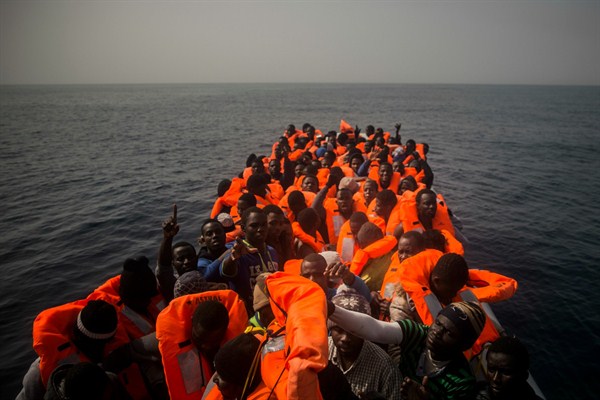Waves of violence and economic hardship are changing patterns of migration around the world, at a moment when parties with nationalist and anti-immigrant platforms gain momentum in the West. World Politics Review compiled 15 articles that shed light on the drivers of today’s migrant crises and the forces underpinning an increasingly cold response to those seeking refuge.
The Politics of Migration
Understanding the Global Backlash Against Migration—and Its Costs
U.S. President Donald Trump’s January entry ban for travelers from seven Muslim-majority countries focused attention on a looming shift in American immigration policy. But these developments are not occurring in a vacuum, Frida Ghitis wrote in February. As nationalist policies trend upward around the world, the issue of how to regulate migration is climbing steadily on the global agenda.
Currently the source of the world’s largest migrant exodus, the Syrian war has revealed the inadequacy of international responses to refugees and a system of legal protections that doesn’t reflect the contemporary landscape of conflict and displacement. In December, Matthew J. Gibney exposed the failures of current policies to address the refugee crisis, as developed countries increasingly outsource their obligations to poorer nations. Will the lessons from Syria lead to an overhaul?
Beyond displacement from war and instability, climate-driven migration will also affect millions of people in the coming decades, Ellen Laipson warned last August. As climate change renders now-populated areas uninhabitable, states and international organizations will need to dedicate additional resources to support climate migrants.
Shifting Priorities in Latin America
On their way toward the United States, a growing number of Central Americans fleeing violence in Guatemala, Honduras and El Salvador are now seeking asylum in Mexico. Laura Weiss reported in February on how they are straining Mexico’s already-weak asylum system. As Trump’s hard-line immigration policies take shape to the north, that burden will only grow.
Below Mexico’s southern border, and below the wave of migrants fleeing north from El Salvador, Honduras and Guatemala, another crisis is unfolding deeper in Central America. Last September, Christine Wade explained how Panama, Costa Rica and their neighbors have become a pressure point for migrants from as close as Cuba and as far away as Africa and South Asia.
In January, Argentine President Mauricio Macri announced new immigration rules that risk repudiating the country’s history and could presage a break with its neighbors. Though the measures are far from draconian and have public backing, Patrick Corcoran argued that they raise important concerns about how migration is being politicized across South America.
A Test for Europe
With over 1 million asylum-seekers and migrants reaching the European Union via the Mediterranean in 2015 alone, the continent is in the midst of a veritable crisis, Judith Sunderland wrote last year. The U.N. Refugee Agency, UNHCR, estimates that 84 percent of those migrants are refugees, half of whom are Syrian. As assimilation in Europe develops into an increasingly contentious issue, the EU response, both in rhetoric and practice, has fallen short.
As more migrants pour in from conflict zones, many European countries have tightened their borders. For decades, Swedes have taken pride in providing a safe haven to the world’s huddled masses. But times have changed, as Rik Rutten reported from Stockholm in January. Like neighboring Denmark, Sweden now finds itself at the bottom of the European Union when it comes to welcoming refugees.
Despite Germany’s open-door policies, the country represents many of the trials that migrants face arriving in Europe. Reporting from Berlin last fall, Josie Le Blond looked at how asylum-seekers, often living in temporary housing or poor conditions, are at the mercy of overwhelmed authorities. As they languish in limbo, many have become nostalgic for the war zone they fled.
Through the Mediterranean
Some of the most compelling dramas about the effects of globalization are playing out in the Mediterranean basin, one of the geopolitical nodes where north and south intersect. But, Ellen Laipson argued in February, we should not commit the error of lumping the crises together. From east to west, three distinct zones in the region show different coping mechanisms with respect to terrorism, migration and economic interdependence.
With the world sensing the permanence of Syria’s refugee crisis, host countries and donors are now focusing on how to provide sustainable livelihoods and integrate Syrians, in particular by bringing them into the workforce. Last September, Saskia van Genugten and Lorraine Charles looked at efforts in Turkey and Jordan, where millions of Syrians have taken refuge.
Last June, the European Commission announced a plan to provide African and Middle Eastern governments with positive and negative economic incentives to assist in curbing migrant and refugee flows to Europe. Critics not only contest the plan’s efficacy but stress its ramifications for human rights, Karina Piser noted, since it would send many refugees to countries with perilous security conditions.
Change in the Asia-Pacific
Europe isn’t alone in taking advantage of the nonbinding nature of international law, Karina Piser wrote last April. For years, Australia has been criticized for shipping refugees to offshore detention centers in Nauru, a Pacific Island country, and Manus Island, in northern Papua New Guinea. Australia’s controversial policies highlight the fragility of international law in dealing with migration and refugee protection.
Boasting one of Asia’s most competitive economies, Japan is a sought-after destination for many migrants in the region. But a rising China—and a poor reputation for Chinese tourists in Japan—has come to drive Japanese policymaking in just a few years, from Okinawa and tourism to migration policy and labor shortages, Chris Burgess wrote in November. Understanding Japan’s social and political shifts requires watching China.
Up until the recent bad press about its policies toward asylum-seekers, Australia, an immigrant nation par excellence, has looked like a secure bastion of liberal multiculturalism. That has started to change. Shanthi Robertson catalogued the ways Australia’s immigration policies are shifting, with stark implications for migration patterns and social cohesion.

